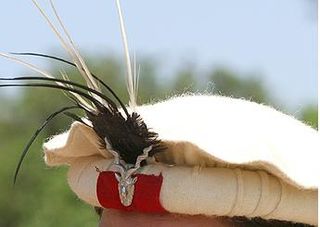
The Nuristani languages, also known as Kafiri languages, are one of the three groups within the Indo-Iranian language family, alongside the much larger Indo-Aryan and Iranian groups. They have approximately 130,000 speakers primarily in eastern Afghanistan and a few adjacent valleys in Khyber Pakhtunkhwa's Chitral District, Pakistan. The region inhabited by the Nuristanis is located in the southern Hindu Kush mountains, and is drained by the Alingar River in the west, the Pech River in the center, and the Landai Sin and Kunar rivers in the east. More broadly, the Nuristan region is located at the northern intersection of the Indian subcontinent and the Iranian plateau. The languages were previously often grouped with Indo-Aryan or Iranian until they were finally classified as forming a third branch in Indo-Iranian.

Chitral District was a district in the Malakand Division of the Pakistani province of Khyber Pakhtunkhwa, from 14 August 1947 to 2018. It was the largest district in the Khyber-Pakhtunkhwa, covering an area of 14,850 km², before splitting into Upper and Lower Chitral Districts in 2018. It was the northernmost district of Khyber Pakhtunkhwa. It shared a border with Gilgit-Baltistan to the east and with Swat and Dir districts of Khyber Pakhtunkhwa to the south. It also shared an international border with Afghanistan to the north and west. Afghanistan's narrow strip of Wakhan Corridor separated Chitral from Tajikistan in the north.

Chitral is a city situated on the Chitral River in northern area of Khyber Pakhtunkhwa. It serves as the capital of the Lower Chitral District, and was previously the capital of Chitral District, and before that the capital of Chitral princely state. The region was encompassed into West Pakistan between the years 1969 and 1972. It has a population of 49,780 per the 2017 census.
The Katir are a Nuristani tribe in Afghanistan and Pakistan.

Khowar, or Chitrali, is a Dardic language of Indo-Aryan language family primarily spoken in Chitral and surrounding areas in Pakistan.

Kalasha is an Indo-Aryan language spoken by the Kalash people, in the Chitral District of Khyber Pakhtunkhwa province of Pakistan. There are an estimated 4,100 speakers of Kalasha. It is an endangered language and there is an ongoing language shift to Khowar.

Palula and also known as Ashreti (Aćharêtâʹ) or Dangarikwar, is an Indo-Aryan language spoken by approximately 10,000 people in the valleys of Ashret and Biori, as well as in the village of Puri in the Shishi valley and at least by a portion of the population in the village Kalkatak, in the Chitral District of Khyber Pakhtunkhwa province of Pakistan.

The pakol or pakul is a soft, flat, rolled-up, round-topped men's cap, usually worn in Afghanistan and Pakistan. It is typically made of wool and found in a variety of earthy colours, such as brown, black, grey, ivory, or dyed red using walnut. The pakol is believed to have originated in Chitral, or Gilgit-Baltistan in Pakistan.

Kamviri is a dialect of the Kamkata-vari language spoken by 5,000 to 10,000 of the Kom people of Afghanistan and Pakistan. There are slight dialectal differences of the Kamviri speakers of Pakistan. The most used alternative names are Kati, Kamozi, Shekhani or Bashgali.

Torwali is an Indo-Aryan language spoken by the Torwali people, and concentrated in the Bahrain and Chail areas of the Swat District in Pakistan. The Torwali language is said to have originated from the pre-Muslim communities of Swat. It is the closest modern Indo-Aryan language still spoken today to Niya, a dialect of Gāndhārī, a Middle Indo-Aryan language spoken in the ancient region of Gandhara.
Kata-vari (Kâta-vari) is a dialect of the Kamkata-vari language spoken by the Kata in parts of Afghanistan and Pakistan. The most used alternative names are Kati, Kativiri or Bashgali.

Kamkata-vari is the largest Nuristani language. It contains the main dialects Kata-vari, Kamviri and Mumviri. Kata-vari and Kamviri are sometimes erroneously reckoned as two separate languages, but according to linguist Richard Strand they form one language.

The Kho or Chitrali people, are an Indo-Aryan ethnolinguistic group native to the Chitral District in Khyber Pakhtunkhwa and the Gupis-Yasin and Ghizer districts in Gilgit-Baltistan of Pakistan. They speak an Indo-Aryan language called Khowar.
Khouzh is a village located in Upper Chitral, a district in the Khyber Pakhtunkhwa province of Pakistan. The village is situated between the Koh Hindukush and Hindu Raj mountain ranges, with the Chitral River flowing along its borders. Khouzh is home to a diverse community of people who speak the local language of Khowar. Khouzh is located 130 km from Chitral town.It has surface elevation of 2408 meters.

Lower Chitral District is a district in Malakand Division of Khyber Pakhtunkhwa province in Pakistan.

Upper Chitral District is a district in the province of Khyber Pakhtunkhwa, Pakistan. Chitral River flows throughout the district. Upper Chitral District along with the Lower Chitral District were part of the erstwhile Chitral District which was the largest district in the Khyber-Pakhtunkhwa province of Pakistan, covering an area of 14,850 km2. Likewise, it served as the Chitral princely state that encompassed the region until its direct incorporation into the Khyber Pakhtunkhwa province of Pakistan in 14 August 1947. Upper Chitral District and Lower Chitral District were bifurcated from the erstwhile Chitral District in November, 2018.
The Yidgha-Munji people also known as Mukhbani are the Iranian-Pamiri peoples inhabiting the Lotkoh Valley in Chitral and Kuran wa Munjan District in Badakhshan in both Pakistan and Afghanistan.
Madaklasht is a valley located in Lower Chitral district, Khyber Pakhtunkhwa, Pakistan. The valley is predominantly inhabited by the Tajik people who speak Madaklashti, a dialect of Persian.













